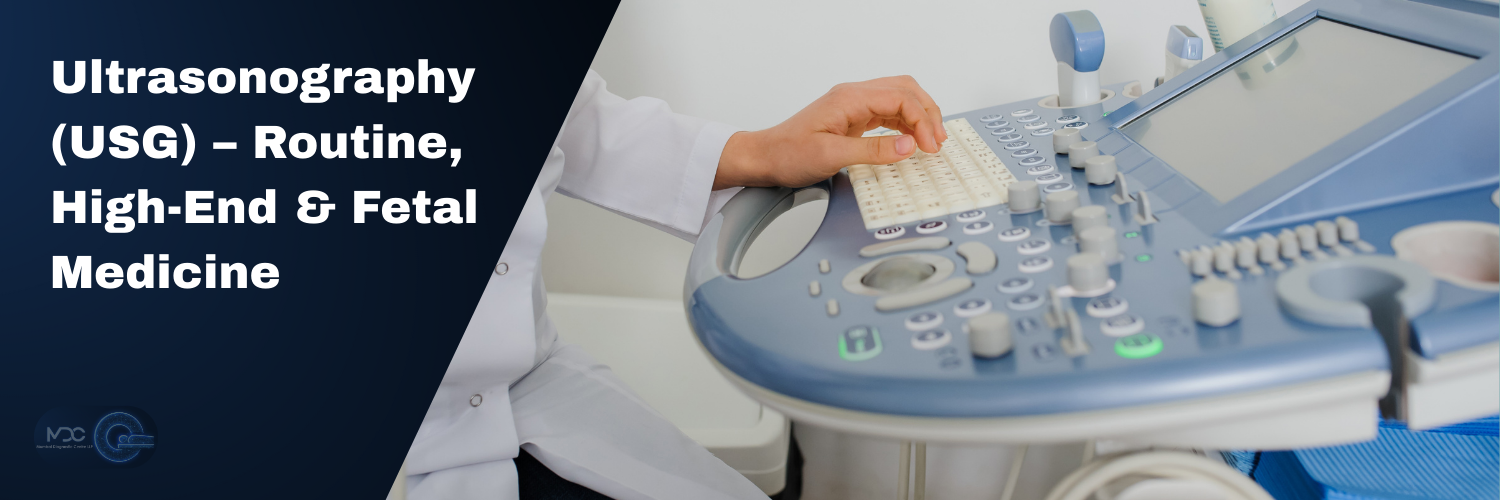What is Ultrasonography (USG)?
Ultrasonography (USG) is a safe, non-invasive imaging technique that uses high-frequency sound waves to create real-time images of your organs, tissues, and blood flow. It is widely used for diagnosis, monitoring, and guiding medical procedures without using radiation.
Types of Ultrasonography
Routine USG
- Abdominal USG (evaluates liver, kidneys, and gallbladder)
- Pelvic USG (assesses uterus, ovaries, and prostate)
- Thyroid USG (checks thyroid gland)
- Breast USG (detects lumps, cysts, or abnormalities)
High-End USG (Advanced Imaging)
- Doppler USG (measures blood flow in vessels, heart, or placenta)
- 3D/4D USG (detailed imaging, especially for fetal scans)
- Contrast-Enhanced USG (used for tumor or lesion characterization)
- Musculoskeletal USG (assesses joints, tendons, ligaments)
Fetal Medicine USG (Pregnancy Scans)
- Dating Scan (6-9 weeks – confirms pregnancy and due date)
- NT Scan (11-14 weeks – screens for Down syndrome)
- Anomaly Scan (18-22 weeks – checks fetal anatomy)
- Growth Scan (3rd trimester – monitors baby’s development)
- Fetal Doppler (assesses blood flow to the baby)
Why Do I Need a USG?
Your doctor may recommend this test to:
- Diagnose abdominal or pelvic pain, gallstones, or kidney issues
- Monitor pregnancy and the health of the fetus (see our Fetal Medicine section for more)
- Evaluate blood flow blockages (DVT, carotid artery)
- Guide biopsies or needle aspirations
- Detect tumors, cysts, or infections
Preparation Guidelines
- Abdomen/Pelvic USG: Fast for 6-8 hours (water allowed)
- Bladder USG: Drink 4-5 glasses of water 1 hour before – full bladder needed
- Pregnancy USG: No fasting – follow clinic instructions
- Wear loose clothing for easy access to the scanned area
- Avoid lotions/oils on the skin (can interfere with the probe)
What to Expect During the Scan
- You’ll lie on an exam table – gel is applied to your skin.
- A transducer (probe) is moved over the area – painless, slight pressure.
- Images appear on a screen in real-time – technician may take measurements.
- Scan time: 15-30 minutes (depends on the type of USG).
Procedure Time
- Total visit time: 30-45 minutes
- Scan duration: 15-30 minutes
- Results: Immediate (routine scans) or within 24 hours (detailed reports).
Post-Scan Guidelines
- No recovery needed – resume normal activities.
- Wipe off gel (hypoallergenic, non-sticky).
- For pregnancy scans: Follow-up as advised by your doctor.
Key Advantages of USG
- No radiation – safe for all ages, including pregnant women.
- Painless & non-invasive – no needles or injections.
- Real-time imaging – useful for guiding procedures.
- Early detection of abnormalities or diseases.
For high-risk pregnancies, Fetal Medicine USG provides critical insights into your baby’s health. For more detailed information on pregnancy monitoring, please check our Fetal Medicine section.
